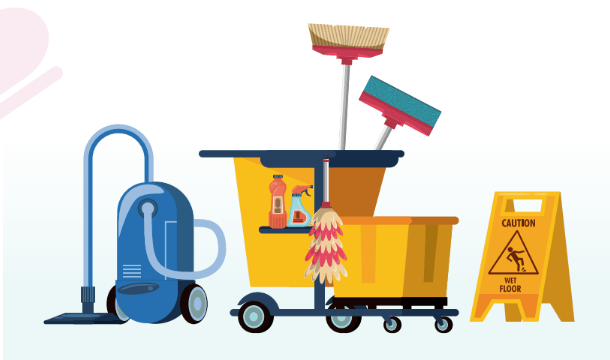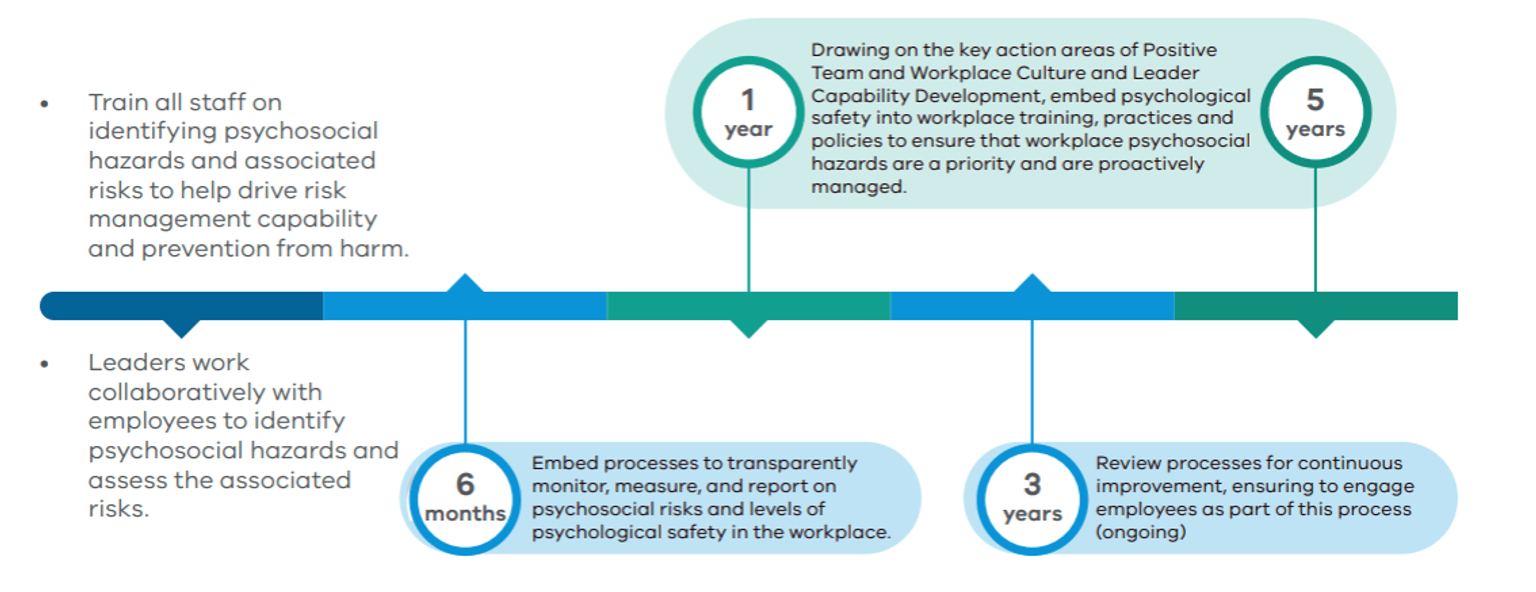Mentally healthy workplaces:
- Promote wellbeing and positive aspects of work,
- Identify and manage risks to create a fair and safe workplace (please see WorkSafe Victoria(opens in a new window) for additional guidance).
- Respond early to warning signs, with effective tools, skills and commitment.
Our workplaces have a big role to play towards our wellbeing. In 2021-2022 in Victoria, more than 4000 claims received by WorkSafe Victoria were for mental injuries.
We need to support industries, workplaces, leaders, supervisors, managers and workers to promote, protect and respond to mental health and wellbeing in the workplace.
In February 2021, the Royal Commission into Victoria’s Mental Health System (RCVMHS) handed down its Final Report outlining key recommendations to the Victorian Government. This Victorian Mentally Healthy Workplaces Framework (‘the Framework’) has been developed in response to the Victorian Government committing to implementing all recommendations of the Royal Commission, part of which involves delivering a state-wide framework to support mentally healthy workplaces.
Work is underway to support mentally healthy workplaces in Victoria. This includes changes to Occupational Health and Safety regulations to better address risks to the psychological health of workers. WorkSafe Victoria provides workplaces with tools, templates, and resources to address work-related factors that impact mental health and promote good practice.
The Framework complements existing resources developed by WorkSafe Victoria, the National Workplace Initiative and Business Victoria to help support Victorian workplaces implement good practices. It includes:
- 3 foundational features
- ‘promote’, ‘protect’, and ‘respond’
- 6 areas of focus
- to drive and enable mentally healthy workplaces
- 5 starting actions
- with clear, effective, and practical steps for organisations to take
- 6 best practice ways
- to guide how to implement the Framework in each workplace
The Framework
The Framework includes guidance on foundational features, areas of focus, places to start and how to implement the Framework to build a mentally healthy workplace
Foundational elements
There are three foundational elements, which are all required to develop a mentally healthy workplace.
Promote
Mentally healthy workplaces recognise and promote the positive aspects of work, including:
- Seeking ways to support good mental health and wellbeing.
- Identifying and building on ‘what is working well’.
- Supporting workers and teams to use their strengths.
- Providing learning opportunities.
- Encouraging workers to collaborate to build a mentally healthy workplace.
Protect
Mentally healthy workplaces take steps to prevent physical, environmental and psychological harm to workers, including:
- Identifying and assessing risks to psychological health.
- Evaluating and proactively managing psychosocial hazards.
- Engaging in good work design, which involves workers having input into how they manage and complete their own tasks.
- Reviewing the wider workplace environment to ensure safety. (e.g., worker and customer interactions and effectively managing any conflicts).
(Please see WorkSafe Victoria for additional guidance).
Respond
Mentally healthy workplaces identify and respond early to any warning signs of distress, declining wellbeing and mental ill-health. This is to make sure that people are given appropriate support. This includes:
- Being prepared to support workers.
- Responding early to any warning signs to improve the likelihood of better health and wellbeing outcomes, which in turn may also lead to better workplace outcomes (e.g. reduced absenteeism).
All three features are related, interconnected and have a more positive impact on the workforce and workplace when considered together.
Areas of focus
There are six areas of focus to drive and enable mentally healthy workplaces, which have a more positive impact when considered to be related and interconnected.
External factors and specific industry circumstances will influence what areas of focus your workplace may consider.
Where to start
In developing and implementing a mentally healthy workplace, start with these five priority actions:
- A Strategy / Action Plan
- Positive team and workplace culture
- Leadership capability development
- Aligned structures, policies and practices
- Proactive risk management
How to implement the Framework
Tools to implement the Framework
A suite of tools to support organisations developing a mentally healthy workspace
Key terms and their meaning
Your Strategy and Action Plan for a Mentally Healthy Workplace
The following introduction outlines the purpose of the guide to developing your own Mental Health and Wellbeing Strategy and Action Plan.
Background
Workplaces that invest in creating a mentally healthy and safe workplace have been shown to have high employee satisfaction and engagement, lower costs associated with absence and turnover, and other economic and social benefits. A mentally healthy workplace is good for everyone and good for business. All workplaces are legally required to provide a physically, environmentally, and psychologically safe work environment.
This guide is designed to support your organisation to:
- Establish a vision and goals
- for creating a mentally healthy workplace
- Identify priority areas and key actions
- as well as roles / responsibilities of leadership and workers
- Create metrics
- to measure progress towards goals
- Identify hazards and control risks
- which may negatively impact on a mentally healthy workplace
How to use this guide
Tips
Download the guide, templates and examples
Guide to developing your Strategy and Action Plan
The following four steps will support your organisation to create a Mentally Healthy Workplace Strategy and Action Plan.
Step 1: Create the vision and goals for your mentally healthy workplace
Step 2: Undertake a current state assessment
Step 3: Identify the priority areas and develop an Action Plan
Step 4: Develop metrics to evaluate and track progress made on your Action Plan
Optional summary step: Your Mentally Healthy Workplace Strategy and Action Plan on a page
Download a PDF version of the guide
Supporting the recovery-at-work and return-to-work of a worker
Building awareness, understanding, behaviours and actions to support recovery-at-work and return-to-work
Background
People experiencing injury, whether physical or psychological, often benefit from staying connected with work and their colleagues during times of recovery; this is called recover-at-work. In some circumstances, it is appropriate for a worker to step away from work for a period of time, and be supported during that time, before returning to work; this is called return-to-work. For further information about returning to work, see WorkSafe Victoria.
This guide has been developed for organisations supporting workers recovering-at or returning-to-work and maintaining health at work after experiencing a psychological illness or injury. This guide is relevant for organisations whether the worker was injured in the workplace or not.
The guide is designed to:
- Build awareness and understanding about recovery-at-work and return-to-work after psychological illness or injury and what this means for different types of workers and organisations.
- Outline the behaviours and actions organisations and people can take to ensure a supportive workplace for recovery-at-work / return-to-work.
How to use this guide
What is recovery-at-work and why is it important?
When a worker who has experienced or is currently experiencing an illness or injury chooses to remain at work during their recovery. This is often a personal preference (under guidance from their GP or medical practitioner) and with the support of the organisation.
Usually, when the workplace supports recovery at work for a worker, the workplace offers modified duties, tasks and roles to accommodate and cater for the needs of the worker during their recovery (e.g. reduced hours, task modification).
It may be helpful to offer the ‘recovery at work’ option to the ill or injured worker, who may not be aware that this as an option, during times of illness or injury.
What is return-to-work and why is it important?
An individual worker returning to work after having a period away from work due to illness or injury.
The worker may not need to be 100 per cent well to return to work. Obtaining guidance from their treating health practitioner can be helpful in determining the ideal time for a worker to return to work.
How to support someone to recover-at or return-to-work
As an employer or supervisor, you play a valuable role in supporting someone’s recovery from psychological injury or illness. There are several easy steps that any organisation can take to ensure that you are supporting a worker’s recovery-at- or return-to-work.
This can look different for everyone and there is no one-size-fits all approach. Consider gender or other attributes such as being a young individual, migrant individual, person with disability, an individual identifying as LGBTIQ+ or an individual from a culturally and linguistically diverse background.
As such, it is important to consider the potential gender and/or intersectional impacts, and barriers these individuals may face to recovery-at or return-to-work. It is also important to recognise, understand and respect peoples lived / living experiences and not to pass judgement, or apply your own experience or bias on how a worker approaches or handles their injury, illness, and recovery. Respecting a person's privacy is essential.
The needs of your workers may also change depending on the length of time that they have been away from work. You should support your workers in a way that is tailored to their individual circumstances.
Confidentiality is an essential element that you need to consider. It is best agreed between the person experiencing the illness or injury and the person who is managing their recovery-at or return-to-work. It requires clarity on what is shared (or not), with whom and under what circumstances. It is helpful to review and update the confidentiality agreement from time to time.
Additional Tips
Download this tool as a PDF
Checklist 1: for small to large organisations
The following checklist helps your small to large organisation support the recovery-at-work and return-to-work of a worker after a psychological illness or injury
Checklist 1: For small to large organisations
Download the checklist in PDF format
Checklist 2: for sole traders
The following checklist is to help a sole-trader in their recovery-at-work or return-to-work journey after a psychological illness or injury.
Checklist 2: For sole traders
Download the checklist in PDF format
Supporting workers in short-term, casual, insecure or irregular roles
Guidance and awareness on key issues experienced by people in temporary work, and suggested actions
Background
People in short-term, casual, insecure or irregular work can feel disconnected and isolated from their colleagues and team. This can lead to declining wellbeing and mental ill-health for these individuals.
Certain groups of people (e.g. women, young individuals, migrant individuals, and individuals from a culturally and linguistically diverse background) are at an increased risk within a workplace, and are typically employed in short-term, casual and irregular roles.1
As an employer, you have an obligation to provide and maintain a working environment for your workers that is safe and free from risks to their mental health and wellbeing, so far as reasonably practicable.
How to use this guide
1. Read the following key issues and examine if they resonate with the workers and roles in your workplace
2. Undertake the suggested actions, and tailor this to your workplace, to mitigate key issues
Definitions to describe the different working arrangements of temporary work
Download this tool in PDF format
Key issues and suggested actions
How to support workers in short-term, casual, insecure or irregular roles
The following guide outlines some key issues that are experienced by people in temporary work, and some suggested actions that you as an employer can take to support these individuals in their roles.
To read more about supporting workers in short-term, casual, insecure or irregular roles, see these examples of actions you can take:
Staying connected to the team
Connection to leadership
Communication
Availability of learning and development
Granting equal opportunities and benefits
Small business self assessment tool
About this tool
This free self-assessment tool is designed for small businesses. It has been developed to provide a quick and useful way for you to:
- understand what your business is doing well to support a mentally healthy workplace
- identify areas for improvement for a more mentally healthy workplace
- make informed decisions on actions and initiatives to drive a mentally healthy workplace.
This tool is a survey designed to assess key behaviours/observations related to six areas of focus:
- leadership and accountability
- education and capability
- culture
- inclusion
- policies and practices
- risk prevention.
The six areas of focus relate to key characteristics within a workplace that help make it mentally healthy. The content within this tool has been designed based on existing evidence-based resources, including:
- Workplace Wellbeing Assessment – News South Wales Government
- Mentally Healthy Workplaces during COVID-19: Small Businesses - National Mental Health Commission
- Small Business and Mental Health – Through the Pandemic – The Australian Government the Treasury
- Work and Mental Health – Beyond Blue
Who this tool is for
This tool should be completed by your workers at any time that suits your business to give you a deeper understanding, as a small business owner, about where to focus attention and what to do next. It is recommended that you also engage with the tool and self-assess, using the Small Business Owner section of the tool. Further guidance around useful approaches is provided below.
How to use this tool
The survey takes approximately 10 minutes to complete for small to medium businesses, and approximately five minutes for sole traders. Scores are assessed on a 5-point scale, then added to provide an overall score for each domain. Prepare and send introductory communication to workers to provide them with details about the survey and why it is being implemented. Below, you can find guidance on how to communicate this to your workers. Once introductory communications have been shared with your staff, the following steps should be taken:
The Victorian Mentally Healthy Workplaces Framework fact sheets
About the Victorian Mentally Healthy Workplaces Framework
This summary explains the important parts of the Framework. It aims to help you create a mentally healthy workplace.
The Victorian Mentally Healthy Workplaces Framework - key focus areas
There are six areas you should focus on when thinking about the mental health and wellbeing of people in a workplace.
The Victorian Mentally Healthy Workplaces Framework - how to get started
Start with these five actions to create your mentally healthy workplace.
Information about The Framework in your language
Information about the Victorian Mentally Healthy Workplaces Framework in your language
The Victorian Mentally Healthy Workplaces Framework - how to get started
Start with these five actions to create your mentally healthy workplace. For small to large organisations, try to include your workers in each one.
Think about your goals and actions
What are the goals and values of your business? Now think about why you want to create a mentally healthy workplace and what your vision is. To help answer these questions, think about what is working well in your business and what isn’t. Once you know what is working well and what isn’t, pick the key areas to start creating your mentally healthy workplace. The Victorian Government has created a guide to help.
For example, your workplace has flexible work hours to help workers manage their children’s school drop-off and pick-up hours. Your workers feel like their mental health and wellbeing is being supported because of this. But they don’t feel like there are enough training programs. Talk to your workers about what they would like to learn more about to help them grow in the workplace.
Create a positive team and workplace culture
Create a positive workplace culture that supports a personal and professional safe environment. To help get started, think about your workplace and if it promotes trust and a culture of speaking up. For workers struggling with mental health and wellbeing, work together to make changes. For example, offer support that meets their individual needs and situation.
Grow and improve leadership
Leaders that value mental health and wellbeing are good for your business and your workers. Support and promote opportunities for all workers to grow and develop their understanding of mental health. Think about giving leaders the training and support to manage people, especially through difficult times.
For example, ask leaders at your workplace if they feel supported and empowered to show vulnerability. Do they know how to safely speak about their lived experience in the workplace? Do your leaders understand their role in creating a mentally healthy workplace?
Policies, practices and systems
Your workplace should consider the mental health and wellbeing of workers in all practices. This includes workplace policies and systems. To get started, ask yourself if your workplace already has mental health policies in place. Are they helping your workers and your business needs? Do you need to design policies and systems to create a mentally healthy workplace? To help answer these questions, talk to your workers,
and make changes together.
Proactive risk management
Sometimes psychosocial hazards happen at work. Psychosocial hazards are parts of work that can lead to work-related stress or harm if they’re ignored. This could be long work hours, high and low job demands or no emotional support from managers. Think about your workplace and its psychosocial hazards. Talk to your workers about how you can reduce or avoid them. Make sure psychosocial hazards are reported and measured with openness and honesty.
For example, train workers on what psychosocial hazards are and how to reduce them in the workplace. You might do this yourself or get an external trainer to do this for you. WorkSafe Victoria also has a range of resources available.
The Victorian Mentally Healthy Workplaces Framework - key focus areas
There are six areas you should focus on when thinking about the mental health and wellbeing of people in a workplace. As every business is different, some of the areas of focus might not apply to your workplace.
Leadership and accountability
Leaders in a workplace are responsible for showing everyone else how to do things. They need to lead the way by showing how safety, mental health and wellbeing is a key focus for the business.
Culture
Workplace culture can mean different things to everyone. But it’s important to focus on a positive workplace culture. This can include promoting diversity, inclusion, respect, collaboration, and reward and recognition. It’s also important for workers and teams to feel a sense of meaning and purpose in their work.
Policies and practices
Many workplaces have procedures, policies and practices in place. When creating or reviewing these policies, think about employee mental health and wellbeing.
Education and capability
Workers understand their own mental health and wellbeing. They also know how to help others. You can help your workers understand mental health and wellbeing though:
- training sessions,
- formal education
- raising awareness of the stigma around mental ill-health.
Inclusion
All workers have equal opportunities to take part in the workplace. This will help workers create healthy and respectful relationships at work.
Risk prevention
Workplaces take measures to reduce all potential harm in the workplace. Please see WorkSafe for further guidance.
About the Victorian Mentally Healthy Workplaces Framework
People often spend a lot of time at their workplace. It's important that workplaces are physically and psychologically safe for all workers.
In February 2021, the Royal Commission into Victoria’s Mental Health System recommended the Victorian Government create guidelines to help employers create safe workplaces. We created the Victorian Mentally Healthy Workplaces Framework (the Framework).
The Framework helps business owners, supervisors, managers and workers to improve mental health and wellbeing in the workplace.
This summary explains the important parts of the Framework. It aims to help you create a mentally healthy workplace. A mentally healthy workplace is good for everyone and good for business.
How to know your workplace is mentally healthy
You can spot a mentally healthy workplace if it does these 3 things:
- Promotes and recognises the positive parts of work.
- Takes steps to prevent physical, environmental and psychological harm to workers.
- Identifies and responds early to warning signs of declining wellbeing and mental health. People also feel supported in the workplace.
Promote
- Supporting workers and teams to use their strengths.
- Providing learning opportunities.
- Encouraging workers to collaborate to build a mentally healthy workplace
Protect
- Identifying and assessing risks to mental health and wellbeing.
- Evaluating and proactively managing psychosocial hazards.
- Workers having input into how they manage and complete their own tasks.
Respond
- Supporting workers experiencing mental distress or ill-health.
- Responding early to any warning signs to improve the likelihood of better health and wellbeing outcomes.
Information about The Framework in your language
The Victorian Mentally Healthy Workplaces Framework - العربية (Arabic)
إطار عمل الصحة النفسية لسكان فيكتوريا في أماكن العمل هتيهام العربية (About the Victorian Mentally Healthy Workplaces Framework - Arabic)
The Victorian Mentally Healthy Workplaces Framework - हिन्दी (Hindi)
विक्टोरियाई मानसिक रूप से स्वस्थ कार्यस्थल ढाँचा इसके बारे में (About the Victorian Mentally Healthy Workplaces Framework) - हिन्दी (Hindi)
The Victorian Mentally Healthy Workplaces Framework - 简体中文 (Simplified Chinese)
关于 维多利亚州促进精神健康的工作场所框架 (About the Victorian Mentally Healthy Workplaces Framework) - 简体中文 (Simplified Chinese)
The Victorian Mentally Healthy Workplaces Framework - 繁體中文 (Traditional Chinese)
簡介 維州心理健康 工作場所框架 (About the Victorian Mentally Healthy Workplaces Framework) - 繁體中文 (Traditional Chinese)
The Victorian Mentally Healthy Workplaces Framework - Tiếng Việt (Vietnamese)
Giới thiệu về Khuôn khổ Nơi làm việc Lành mạnh về Tinh thần của bang Victoria (About the Victorian Mentally Healthy Workplaces Framework) - Tiếng Việt (Vietnamese)
Glossary
Terms and definitions used in the Victorian Mentally Healthy Workplaces Framework
The terms and the definitions used for the purposes of the Framework are below:
| Term | Definition for the purposes of this Framework |
|---|---|
| Absenteeism | Absenteeism is when an employee is absent from work for lengths beyond what is considered an acceptable time span. |
| Continuous Improvement | An ongoing effort to improve services, or processes. These efforts can seek "incremental" improvement over time or "breakthrough" improvement all at once. |
| Diversity | Diversity is also about recognising, respecting and valuing differences based on ethnicity, gender, age, race, religion, disability and sexual orientation. It also includes an infinite range of individual unique characteristics and experiences, such as communication style, career path, life experience, educational background, geographic location, income level, marital status, parental status and other variables that influence personal perspectives. |
| Integrated approach | An integrated approach to creating and maintaining a mentally healthy workplace ensures that interventions protect mental health by reducing work–related risk factors, promote good mental health by developing the positive aspects of work, and respond to mental ill-health, irrespective of cause. (LaMontagne et al.) |
| Intersectionality | Refers to the ways in which different aspects of a person’s identity can expose them to overlapping forms of discrimination and marginalisation. |
| Leader | A person within a workplace who – through their title, role, or responsibilities – has the ability to positively influence the lives of individual co-workers and those within teams or the broader organisation. |
| Lived or Living experience | People with lived/living experience identify either as a person who is living with (or has lived with) mental illness or psychological distress, or someone who is caring for or otherwise supporting (or has cared for or otherwise supported) a person who is living with (or has lived with) mental illness or psychological distress (adapted from Royal Commission into Victoria’s Mental Health System). |
| Mental health | A state of wellbeing in which a person realises their own abilities, can cope with the normal stresses of life, can work productively and is able to contribute to their community (Royal Commission into Victoria’s Mental Health System). This includes ‘social and emotional wellbeing’ which refers to being resilient, being and feeling culturally safe and connected, having and realising aspirations, and being satisfied with life. |
| Mental illness or Mental health condition | Mental illness is a medical condition that is characterised by a significant disturbance of thought, mood, perception or memory. (Victorian Mental Health and Wellbeing Act 2022). In line with the Final Report from the Royal Commission into Victoria’s Mental Health System, we note that people with lived/living experience can have varying ways of understanding the experiences that are often called ‘mental illness’. It acknowledges that mental illness can be described using terms such as ‘neurodiversity’, ‘emotional distress’, ‘trauma’ and ‘mental health challenges’ |
| Mental ill-health or poor mental health | A state of low, declining, or poor mental health and wellbeing impacting negatively on an individual’s mood, energy, thought and/or behaviour that does not meet the criteria for a mental health condition. |
| Mentally healthy workplace | A mentally healthy workplace is a workplace that promotes mental health and wellbeing by recognising and enhancing the positive aspects of work that contribute to good mental health; protects the mental health and wellbeing of its workers by identifying and managing work-related risks to mental health; and responds (early, and irrespective of cause) to the needs of its workers by identifying and responding to support people experiencing declining wellbeing, mental ill-health or distress (adapted from the National Workplace Initiative’s Blueprint for Mentally Healthy Workplaces). |
| Priority population | These include individuals who are typically at a higher risk of experiencing of health inequities (e.g. healthcare access, health outcomes). In Victoria, examples of these individuals include from those from a culturally and linguistically diverse (CALD) background, Aboriginal and Torres Strait Islander people, people experiencing homelessness, and people who identify as LGBTIQ+. |
| Psychosocial | Refers to the involvement of psychological and social factors and the influence that social, emotional, spiritual, and mental influences can have on a person’s wellbeing. |
| Psychological hazard | Psychosocial hazards are factors in the design or management of work that increase the risk of work related stress and can lead to psychological or physical harm (WorkSafe Victoria). Hazards can be work factors and human factors. (Safe Work Australia) |
| Psychosocial risk | Psychosocial risks consider the degree and likelihood of consequence or impact of psychosocial hazards on individuals exposed to the hazards. |
| Psychological safety | Psychological safety is creating an environment where there is a shared belief among team members that they can express themselves, can speak up, share ideas, ask questions, take risks and make mistakes without fear of humiliation, ridicule, embarrassment or retribution. |
| Strengths based approach | A strengths based approach in creating and maintaining a mentally healthy workplace moves the focus away from deficits/problems, and focuses on the strengths (skills, talents, creativity, innovation, knowledge etc) and resources of the people, team and the broader organisation. It is an approach that builds on what is working well, and looks for ways to use these strengths to address vulnerabilities being experienced by teams, workers and the organisation. |
| Stigma | Stigma is when someone sees you in a negative way because of your mental illness. Discrimination is when someone treats you in a negative way because of your mental illness. Social stigma and discrimination can make mental health problems worse and stop a person from getting the help they need. |
| Trauma-informed practice | Trauma-informed practice is an approach that recognises that trauma is common and that people accessing services and people delivering services may be affected by trauma. |
| Work | Includes all forms of work, including full-time, part-time, short term, contract, casual, irregular or insecure work, and volunteering. |
| Worker | The term “worker” has been used in this framework to represent all different ways Victorians are engaged in work. This includes all forms of work, including short term, casual, irregular or insecure work. |
| Workplace | The term “workplaces” or “organisations” has been used in this framework as a catch-all to represent all different types of businesses and places where people conduct work. Unless specifically mentioned, the information provided is guidance for all Victorian business types and all workplace types, including working from home or remote work, and working outdoors |

















